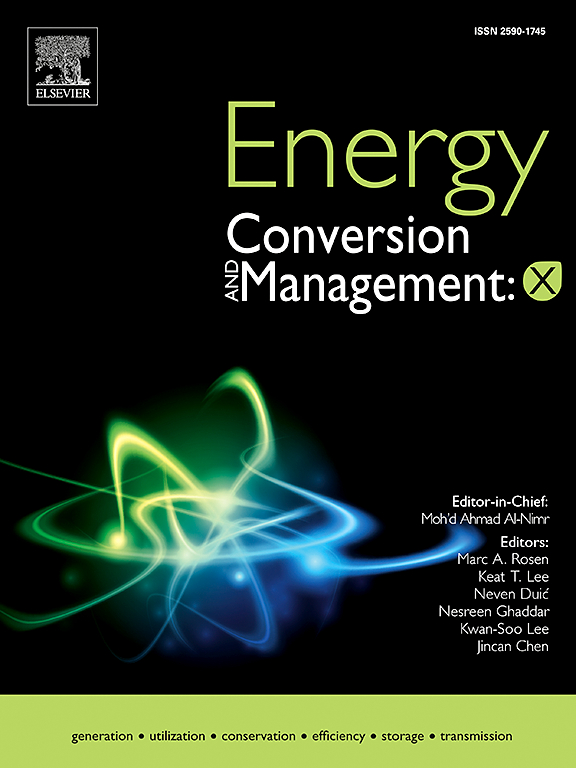固体氧化物燃料电池分析的Levenberg-Marquardt校准算法与CFD建模相结合
IF 10.9
1区 工程技术
Q1 ENERGY & FUELS
引用次数: 0
摘要
电化学数据包括阻抗谱和极化曲线,当数值校准并结合适当的计算流体动力学(CFD)工具时,可以更深入地了解固体氧化物燃料电池(SOFC)阳极和阴极室中的气体流动动力学。在相关文献中,这两种方法(校准和CFD建模)通常是分开进行的。在这项工作中,这两个工具结合起来创建了一个详细的SOFC性能分析框架。考虑到在三种工作温度和两种不同供气情况下对SOFC纽扣电池进行的电化学实验室测量,基于Levenberg-Marquardt算法的校准方法可以估计控制电池极化的主要参数。此外,通过建立在COMSOL Multiphysics上的CFD模型,对进料通道内的气体动力学和多孔电极进行了更深入的研究。通过耦合描述气体在多孔材料中的输运和扩散以及通道内和通过电极的气体流动的各个模块,建立了CFD模型。利用简化的解析公式,Levenberg-Marquardt算法成功拟合了I-V曲线,平均拟合误差小于2%,证明了其有效性。除了研究气体流动动力学外,CFD模型还针对燃料扩散和分压沿阳极厚度的演变进行了分析。结果表明,与分析计算中常用的简单的菲克模型相比,用于CFD模型的麦克斯韦-斯特凡公式在描述气体扩散方面具有更好的精度。例如,根据菲克定律发现的饱和电流密度约为1,8 Acm−2,当使用麦克斯韦-斯蒂芬模型时,得到的饱和电流密度约为2 Acm−2。由于采用麦克斯韦-斯蒂芬公式时,面积比电阻图与实验数据比较好,后一种值被认为更真实。本文章由计算机程序翻译,如有差异,请以英文原文为准。
Combined Levenberg-Marquardt calibration algorithm and CFD modelling for solid oxide fuel cell analysis
Electrochemical data including impedance spectra and polarization curves, when numerically calibrated and combined with proper computational fluid dynamics (CFD) tools, can serve as a deeper understanding of gas flow dynamics in the anodic and cathodic chambers of a solid oxide fuel cell (SOFC). In the related literature, both approaches (calibration and CFD modelling) were usually performed separately. In this work, these two tools were combined to create a detailed framework for SOFC performance analysis. Considering the electrochemical lab measurements made on a SOFC button cell under three working temperatures and for two different gas feeding cases, a calibration approach based on the Levenberg-Marquardt algorithm allowed estimating the main parameters governing the polarization of the cell. Furthermore, a deeper focus is made on the gas dynamics inside the feeding channels and on the porous electrodes through a CFD model built on COMSOL Multiphysics. The CFD model is set up by coupling various modules that describe gas species transport and their diffusion in porous materials as well as gas flow inside the channels and through the electrodes. Using a simplified analytical formulation, the Levenberg-Marquardt algorithm proves its effectiveness by successfully fitting I-V curves with a mean fitting error of less than 2 %. Added to exploring gas flow dynamics, the CFD model is addressed to carrying out an analysis of fuel diffusion and partial pressure evolution along the anode thickness. It was concluded that the Maxwell-Stefan formulation, used in the CFD model, showed better precision in describing gas diffusion compared to the simpler Fick model usually used for analytical calculations. For instance, a saturation current density that was found to be around 1,8 Acm−2 based on the Fick's law , was obtained to reach around 2 Acm−2 when the Maxwell-Stefan model was used. The latter value is seen to be more realistic since the area specific resistance plots compare better with experimental data when the Maxwell-Stefan formulation was applied.
求助全文
通过发布文献求助,成功后即可免费获取论文全文。
去求助
来源期刊

Energy Conversion and Management
工程技术-力学
CiteScore
19.00
自引率
11.50%
发文量
1304
审稿时长
17 days
期刊介绍:
The journal Energy Conversion and Management provides a forum for publishing original contributions and comprehensive technical review articles of interdisciplinary and original research on all important energy topics.
The topics considered include energy generation, utilization, conversion, storage, transmission, conservation, management and sustainability. These topics typically involve various types of energy such as mechanical, thermal, nuclear, chemical, electromagnetic, magnetic and electric. These energy types cover all known energy resources, including renewable resources (e.g., solar, bio, hydro, wind, geothermal and ocean energy), fossil fuels and nuclear resources.
 求助内容:
求助内容: 应助结果提醒方式:
应助结果提醒方式:


